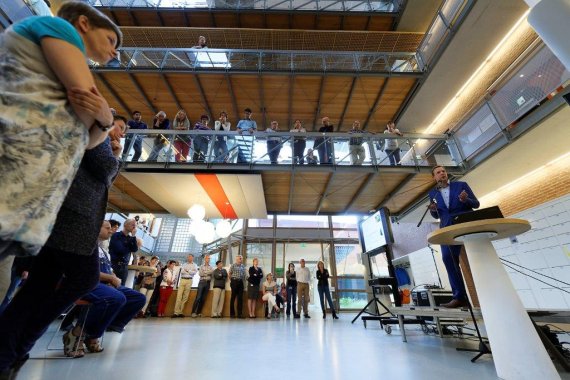<foto: Bram de Vos presenteerde de strategie voor ESG op 14 juni aan het personeel>
Last year Alterra incurred a loss of about four million euros. The shortfall was an effect of falling numbers of research assignments from the ministry of Economic Affairs and of loss-making projects for other clients such as the EU.
Many of Alterra’s research projects do not cover their costs, the management noted. Staff took on projects with little or no margin and did not then manage to arrange co-financing, making the project de facto loss-making. The recovery plan aims at a healthy mix of clients so that Alterra obtains both assignments with little margin and profitable contract research.
We kunnen niet onbeperkt verliesgevende strategische projecten uitvoeren
‘We can’t afford to take on endless loss-making strategic projects,’ the management explains to the staff. ‘That, together with the fact that some staff members are difficult to find work for and do not have enough billable hours, means cutting back by 60 fulltime jobs.’
Temporary contracts
Director Bram de Vos of the Environmental Sciences group (ESG), which Alterra is part of, aims to achieve these cutbacks without any compulsory redundancies. He expects to lose 30 jobs over the next two and a half years through normally timed and early retirements. The other half of the cuts will come from not extending temporary contracts and finding other jobs for staff that are hard to find work for. ‘Alterra researchers have an average of 70 percent billable hours, and that’s got to be 80 percent,’ explains De Vos.
Cruciaal in het Herstelplan is dat de Alterra voortaan voor de start gaat beoordelen of onderzoeksprojecten van bijvoorbeeld de EU kostendekkend zijn of gemaakt kunnen worden met cofinanciering
A crucial part of the recovery plan is that from now on Alterra will assess beforehand whether research projects – such as those from the EU – are cost-covering or can be made so through cofinancing. If the risk is too big or a project is not important enough, the proposal is not accepted. By selecting projects more stringently, Alterra will lose turnover in the coming years. De Vos: ‘We’ve got to be healthy again by the end of 2018, which means getting a positive result.’
No reorganization
If the government cuts turn out higher than expected in the years to come, the management does not rule out firing people. But for the time being the management does not want a reorganization. Not only is speeding up natural staff turnover cheaper than a formal reorganization, but such a reorganization would also cost the jobs of indispensable people, leading to an even bigger loss of turnover.
De Vos also presented a new strategy for the whole ESG this week. In it the emphasis lies on links with the outside world and finding new markets. Alterra needs to start collaborating far more with the university groups in the ESG. Programme leaders have to coordinate Alterra research with university chair-holding professors within six programmes, such as Sustainable water management.
‘Alterra is still too much in the government market,’ says De Vos. ‘We’ve got to get out more and link up with new public-private networks – in the top sectors, for instance.’ The university and institutes also need to present themselves better together. ‘The ministry of Infrastructure and environment, an important ministry for us, doesn’t know enough about what we are doing now.’
The cuts fit the trend of recent years in which Alterra got steadily smaller through dwindling government funding. In 2010 Alterra still had about 500 posts, this year it has about 400, and in 2019 the institute plans to have 340 fulltime posts.

